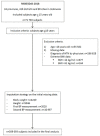Prevalence and risk factors for chronic kidney disease in Indonesia: An analysis of the National Basic Health Survey 2018
- PMID: 36227632
- PMCID: PMC9559178
- DOI: 10.7189/jogh.12.04074
Prevalence and risk factors for chronic kidney disease in Indonesia: An analysis of the National Basic Health Survey 2018
Abstract
Background: The prevalence of chronic kidney disease (CKD) in Indonesia is rising, but the exact extent of the burden of CKD in Indonesia is unknown. To design a screening program for individuals at high-risk, more knowledge is required regarding the prevalence and risk factors of CKD in Indonesia. The latter could have a big impact on the prevention and management of patients with CKD in Indonesia.
Methods: For this purpose, we analysed data from The National Basic Health Survey 2018 (Riset Kesehatan Dasar, Riskesdas 2018), a descriptive cross-sectional study in 34 provinces, 416 districts and 98 cities in Indonesia. We included subjects aged ≥18 years and analysed the prevalence of CKD. Using multiple logistic regression, we investigated the association between CKD and potential risk factors such as demographic factors (age, gender, occupational status, level of education), lifestyle and behaviours (consumption of salty food, consumption of fruit and vegetables, smoking, alcohol consumption, carbonated drink consumption, physical activity), comorbid conditions (hypertension, heart disease, diabetes mellitus, hepatitis, stroke, nutritional status) and others (clean water supply, pregnancy complication, access to health care).
Results: We included 389 093 subjects in this study out of 713 783 subjects that participated in Riskesdas 2018 survey. The prevalence of CKD was 0.5%. The survey included mostly younger adults age 18-59 years (83.1%) with a mean (SD) age of 44.3 (15.1) years. The majority of subjects were female (60.3%), unemployed (58.4%), and the proportion of obese subject was 25.4%. Hypertension was the major comorbid condition (40.8%), while the proportion of diabetes mellitus (DM), heart disease, stroke and hepatitis were quite low (3.3%, 2.6%, 1.7% and 0.5%; respectively). Despite the high proportion of hypertension, only 36.2% of subjects did receive a prescription for anti-hypertensive medication of which only 21.7% used this medication regularly. The multiple logistic regression analysis demonstrated that hepatitis was the strongest risk factor of CKD (odds ratio (OR) = 3.406; 95% confidence interval (CI) = 2.496-4.648), exceeding the risk of CKD in patients with physical inactivity (OR = 1.236; 95% CI = 1.128-1.354), low education status (OR = 1.307; 95% CI = 1.191-1.434), male (OR = 1.527; 95% CI = 1.398-1.668), stroke (OR = 1.916; 95% CI = 1.570-2.338), heart disease (OR = 2.941; 95% CI = 2.356-3.671), and DM (OR = 2.462; 95% CI = 1.979-3.063). We also observed that DM (OR = 4.280; 95% CI = 3.756-4.876) and male subjects (OR = 1.474; 95% CI = 1.352-1.606) were identified as independent risk factors for CKD in hepatitis-positive subjects.
Conclusions: This population-based survey confirmed the increasing burden of CKD in Indonesia and suggested that besides traditional metabolic risk factors, viral hepatitis has proven to be an independent risk factor for CKD in Indonesia. Furthermore, the risk of CKD is greater in male hepatitis patients with DM. The result of this study demonstrates the need for an aggressive screening program for patients with a high risk for the development of CKD. Apart from patients with traditional cardiometabolic risk factors, such a program should include patients with viral hepatitis.
Copyright © 2022 by the Journal of Global Health. All rights reserved.
Conflict of interest statement
Disclosure of interest: The authors completed the ICMJE Disclosure of Interest Form (available upon request from the corresponding author) and disclose no relevant interests.
Figures
References
-
- Badan Penelitian dan Pengembangan Kesehatan, Kementerian Kesehatan Republik Indonesia. Laporan Riset Kesehatan Dasar (Riskesdas) 2018.
MeSH terms
Substances
LinkOut - more resources
Full Text Sources
Medical

